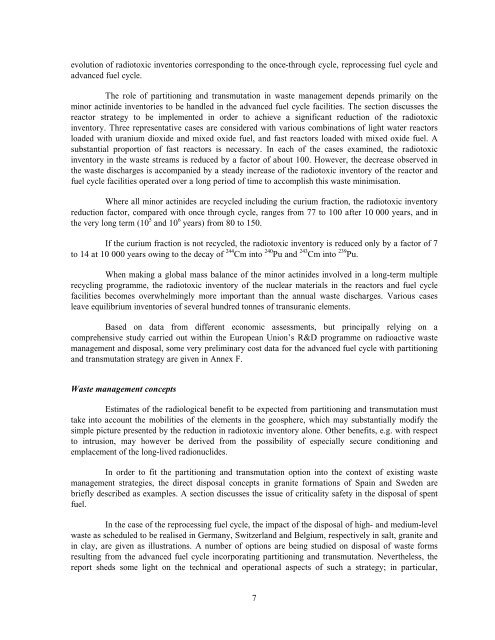COMPLETE DOCUMENT (1862 kb) - OECD Nuclear Energy Agency
COMPLETE DOCUMENT (1862 kb) - OECD Nuclear Energy Agency
COMPLETE DOCUMENT (1862 kb) - OECD Nuclear Energy Agency
Create successful ePaper yourself
Turn your PDF publications into a flip-book with our unique Google optimized e-Paper software.
evolution of radiotoxic inventories corresponding to the once-through cycle, reprocessing fuel cycle and<br />
advanced fuel cycle.<br />
The role of partitioning and transmutation in waste management depends primarily on the<br />
minor actinide inventories to be handled in the advanced fuel cycle facilities. The section discusses the<br />
reactor strategy to be implemented in order to achieve a significant reduction of the radiotoxic<br />
inventory. Three representative cases are considered with various combinations of light water reactors<br />
loaded with uranium dioxide and mixed oxide fuel, and fast reactors loaded with mixed oxide fuel. A<br />
substantial proportion of fast reactors is necessary. In each of the cases examined, the radiotoxic<br />
inventory in the waste streams is reduced by a factor of about 100. However, the decrease observed in<br />
the waste discharges is accompanied by a steady increase of the radiotoxic inventory of the reactor and<br />
fuel cycle facilities operated over a long period of time to accomplish this waste minimisation.<br />
Where all minor actinides are recycled including the curium fraction, the radiotoxic inventory<br />
reduction factor, compared with once through cycle, ranges from 77 to 100 after 10 000 years, and in<br />
the very long term (10 5 and 10 6 years) from 80 to 150.<br />
If the curium fraction is not recycled, the radiotoxic inventory is reduced only by a factor of 7<br />
to 14 at 10 000 years owing to the decay of 244 Cm into 240 Pu and 243 Cm into 239 Pu.<br />
When making a global mass balance of the minor actinides involved in a long-term multiple<br />
recycling programme, the radiotoxic inventory of the nuclear materials in the reactors and fuel cycle<br />
facilities becomes overwhelmingly more important than the annual waste discharges. Various cases<br />
leave equilibrium inventories of several hundred tonnes of transuranic elements.<br />
Based on data from different economic assessments, but principally relying on a<br />
comprehensive study carried out within the European Union’s R&D programme on radioactive waste<br />
management and disposal, some very preliminary cost data for the advanced fuel cycle with partitioning<br />
and transmutation strategy are given in Annex F.<br />
Waste management concepts<br />
Estimates of the radiological benefit to be expected from partitioning and transmutation must<br />
take into account the mobilities of the elements in the geosphere, which may substantially modify the<br />
simple picture presented by the reduction in radiotoxic inventory alone. Other benefits, e.g. with respect<br />
to intrusion, may however be derived from the possibility of especially secure conditioning and<br />
emplacement of the long-lived radionuclides.<br />
In order to fit the partitioning and transmutation option into the context of existing waste<br />
management strategies, the direct disposal concepts in granite formations of Spain and Sweden are<br />
briefly described as examples. A section discusses the issue of criticality safety in the disposal of spent<br />
fuel.<br />
In the case of the reprocessing fuel cycle, the impact of the disposal of high- and medium-level<br />
waste as scheduled to be realised in Germany, Switzerland and Belgium, respectively in salt, granite and<br />
in clay, are given as illustrations. A number of options are being studied on disposal of waste forms<br />
resulting from the advanced fuel cycle incorporating partitioning and transmutation. Nevertheless, the<br />
report sheds some light on the technical and operational aspects of such a strategy; in particular,<br />
7
















